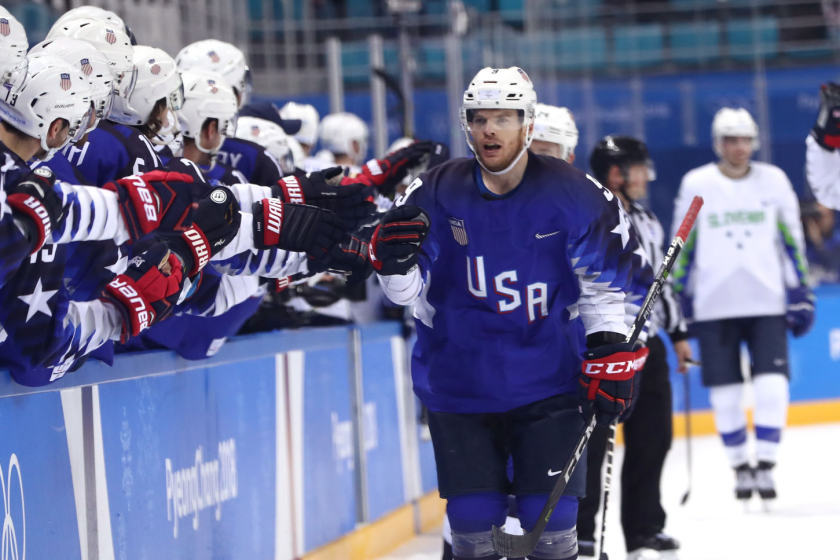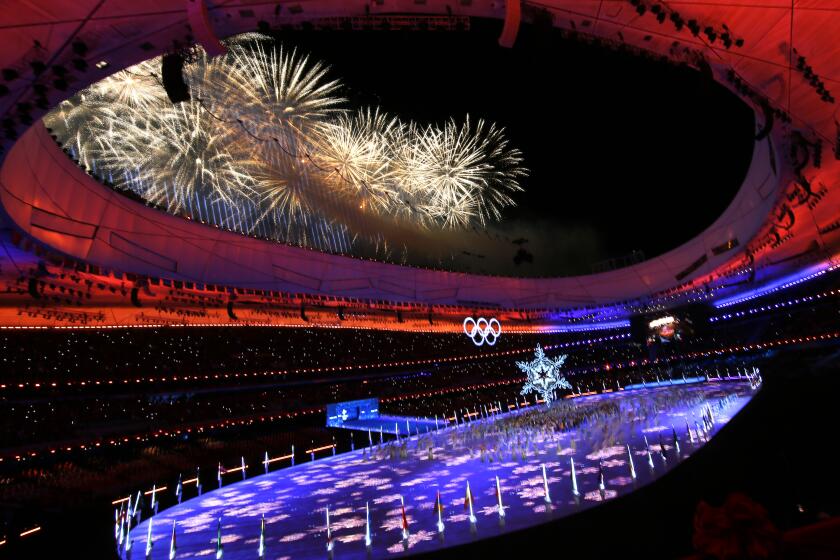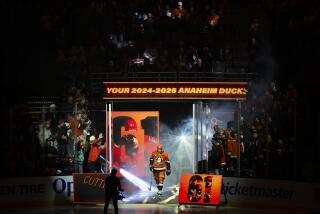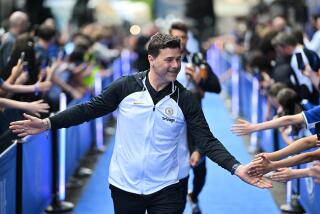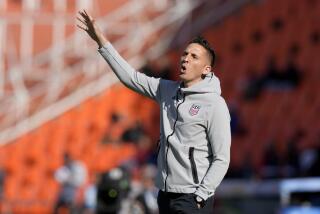Column: U.S. men’s hockey decides to go with young players, unlike in Korea
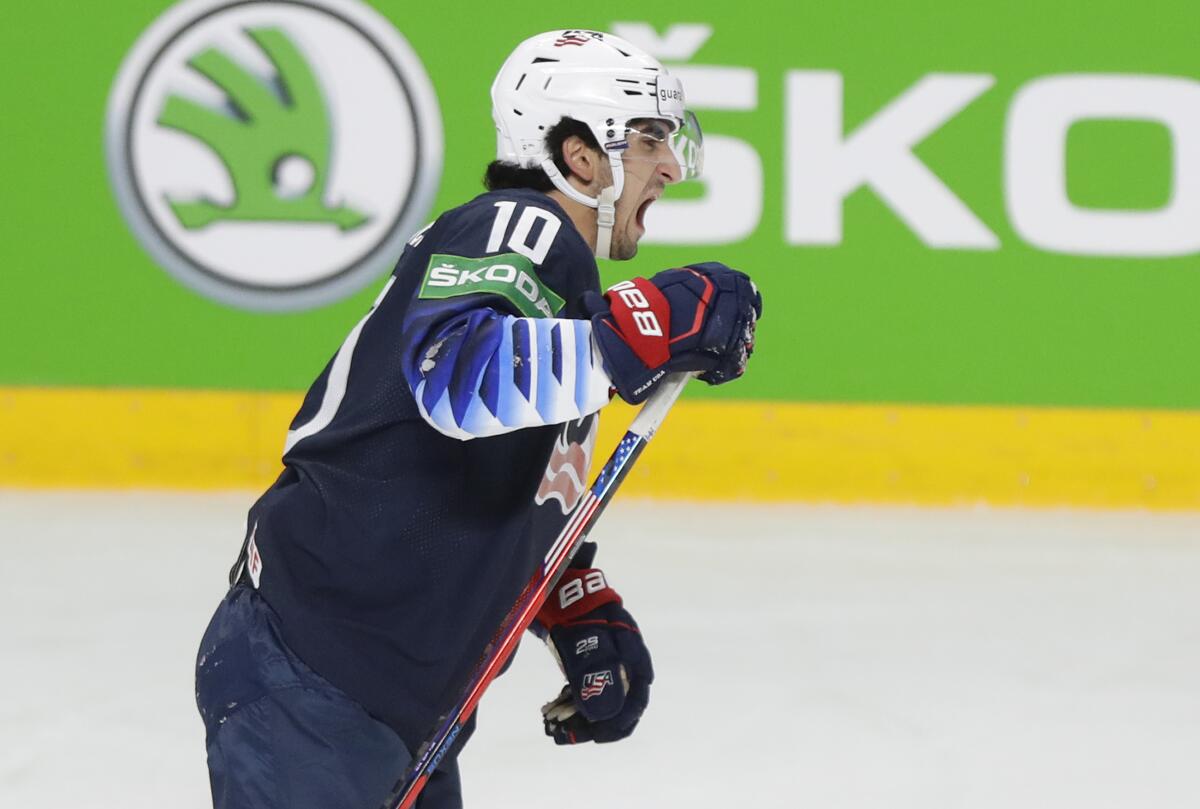
- Share via
BEIJING — The U.S. men’s hockey team hasn’t won Olympic gold since Herb Brooks’ young, energetic college kids overcame prohibitive odds — and the mighty Soviets — before becoming champions in 1980. Hoping to end that drought, architects of the U.S. men’s roster for the Beijing Games reached back to one of Brooks’ many memorably pithy sayings: The legs feed the wolf.
Brooks’ team wasn’t the most skillful in Lake Placid. The Soviets, who trained together most of the year and were professionals by most definitions, were a well-oiled machine and were considered unbeatable. But Brooks made sure his team was the best conditioned, so players had the legs to outskate and outlast their opponents. They feasted when their older, more accomplished rivals faded. Their legs fueled their ambitions and made the impossible become possible.
After the NHL withdrew from the Beijing Olympic tournament in December, citing a pileup of COVID-related postponements that had already disrupted its schedule, U.S. Olympic general manager John Vanbiesbrouck and his staff saw one clear alternative. They would build around speed and construct a roster that would be younger than the seventh-place Pyeongchang team, which comprised mostly older pros playing in Europe and featured only three college players — Ryan Donato, Jordan Greenway, and current Ducks forward Troy Terry.
“The NCAA players that were involved had a big impact on the team. We probably should have brought more of those players,” Vanbiesbrouck said.
USA Hockey selected a men’s Beijing Olympics roster comprised of 15 college players that includes eight players who have been playing in Europe.
The U.S. team that will open play against China on Thursday at National Indoor Stadium has an average age of just over 22, the youngest American squad since 1994. All 25 players played college hockey, and 15 are still in college.
“I think the game is moving toward a speed game,” Vanbiesbrouck said Wednesday. “You often hear coaches talk about getting on top of other teams, meaning putting pressure on their defense and putting pressure on, and I think we want to be a pressure team. The legs give you the opportunity to do that. It’s not going to be all pressure, of course. Playing to that style would make it fun for the players to play, it will make it fun to watch. I mean, we have nothing to lose playing that way.”
And they have everything to gain by offering fans a glimpse of the future and giving young players valuable experience on the world stage — on an NHL-sized ice surface instead of the wider international rink.
Center Matty Beniers of the University of Michigan, who was drafted second in 2021 by the Seattle Kraken, leads a list of prime NHL prospects. Center Brendan Brisson of Manhattan Beach, drafted 29th by the Vegas Golden Knights in 2020, will get a chance to shine. So will defenseman Brock Faber, drafted 45th by the Kings in 2020, and forward Matthew Knies, who was claimed 57th by the Toronto Maple Leafs in 2021. Defenseman Jake Sanderson, drafted fifth by Ottawa in 2020, was due to arrive in Beijing on Thursday after clearing COVID protocols.

“Future stars that are coming up are making impacts on NHL teams immediately,” Vanbiesbrouck said. “We’re acknowledging that, but we’re also saying we want to have some fun with it. We can’t lose sight of how fun this opportunity is for young players and just all around for our staff and our people involved.
“We understand what winning takes, but we also need things to be on our side in order for that to happen. We need to have great goaltending and D and forwards. But we also have to have a whole lot of fun playing and being involved in the biggest stage. I think that’s what we tried to do, maintain that opportunity to have fun, and bringing in the young guys makes it very interesting certainly, I think, for the core hockey fan to watch and say, ‘Who are these guys?’”
The Americans have seven players with NHL experience. Among them is former Kings forward Nick Shore, immortalized by then-coach Darryl Sutter as “the Shore boy.” But the absence of current NHL players makes for an unpredictable tournament.
The Russian Olympic Committee team, coached by former NHL standout Alexei Zhamnov, has the advantage of drawing on its strong domestic league, the KHL. Its roster includes former Kings defenseman Slava Voynov, who left the U.S. rather than face deportation after he served nearly two months in jail for corporal injury to a spouse. The conviction was dismissed in 2018.
Germany, which lost the gold-medal game at Pyeongchang in 2018 to the team then known as Olympic Athletes from Russia, has steadily built up its national team. Canada’s roster includes 37-year-old free-agent forward Eric Staal, who no doubt hopes playing here will lead to a phone call from an NHL team, and budding superstar Owen Power, chosen No. 1 by Buffalo in the 2021 draft. Mason McTavish, who acquitted himself well in a nine-game stint with the Ducks this season after they drafted him No. 3 in 2021, is another potential star.
Recapping the news, results and highlights from The Times’ team of reporters who covered the 2022 Beijing Olympic Games.
Vanbiesbrouck likes the Czechs, whose team features former Boston Bruins star and Stanley Cup winner David Krejci, as well as Michael Frolik (159 goals in 858 NHL games and a Stanley Cup title with Chicago in 2013) and Vladimir Sobotka, who played 548 NHL games for Boston, St. Louis and Buffalo.
“They have a good league and strong players and they’re built for strength. And smarts. They have a great IQ,” Vanbiesbrouck said. “When I look over my shoulder I see former NHL guys that are playing in the tournament and say, ‘Oh, well, they have an edge there.’ But overall it’s hard to tell.”
Vanbiesbrouck’s main hope is that his team’s Olympic experience will be better than his own. He wanted to play for the U.S. in 1984 but instead turned pro in 1981 at 18. In 1998, the first tournament that welcomed NHL players, he played less than one minute as Mike Richter’s backup. This time around, while in Los Angeles to meet the team for its flight to Beijing, he tested positive for the coronavirus. He made a 33-hour drive home to Michigan and will watch the Olympics from there.
“The team’s in good hands,” he said. “I’m probably the least important person.”
His job is done, anyway. It’s up to them to use those legs to feed the wolf.
More to Read
Go beyond the scoreboard
Get the latest on L.A.'s teams in the daily Sports Report newsletter.
You may occasionally receive promotional content from the Los Angeles Times.

